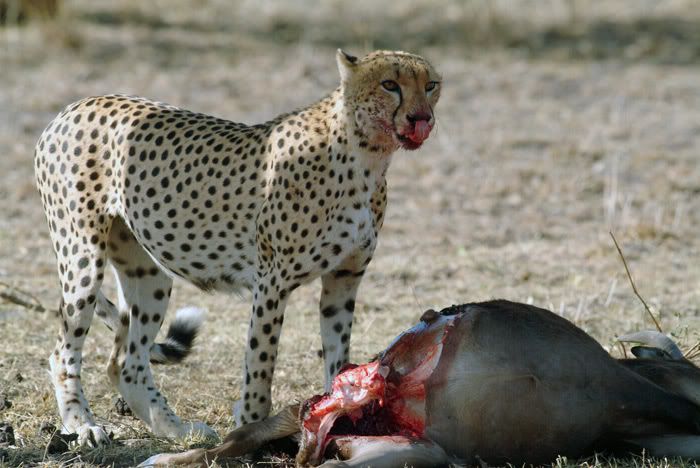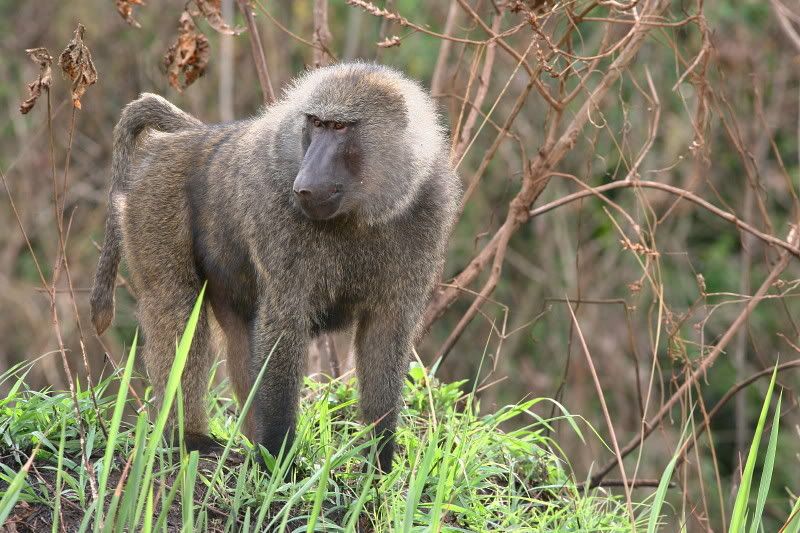Post by dinosauria101 on May 10, 2019 1:18:51 GMT 5
Cheetah - Acinonyx jubatus
The cheetah (Acinonyx jubatus) is a large-sized feline (family Felidae) inhabiting most of Africa and parts of the Middle East. The cheetah is the only extant member of the genus Acinonyx, most notable for modifications in the species' paws. As such, it is the only felid with non-retractable claws and pads that, by their scope, disallow gripping (therefore cheetahs cannot climb vertical trees, although they are generally capable of reaching easily accessible branches). The cheetah, however, achieves by far the fastest land speed of any living animal—between 112 and 120 km/h (70 and 75 mph) in short bursts covering distances up to 500 m (1,600 ft), and has the ability to accelerate from 0 to over 100 km/h (62 mph) in three seconds. The cheetah's chest is deep and its waist is narrow. The coarse, short fur of the cheetah is tan with round black spots measuring from 2 to 3 cm (0.79 to 1.2 in) across, affording it some camouflage while hunting. There are no spots on its white underside, but the tail has spots, which merge to form four to six dark rings at the end. The tail usually ends in a bushy white tuft. The cheetah has a small head with high-set eyes. Black "tear marks" running from the corner of its eyes down the sides of the nose to its mouth keep sunlight out of its eyes and aid in hunting and seeing long distances. Although it can reach high speeds, its body cannot stand long distance running, because it is more suited to short bursts of speed. The adult cheetah weighs from 35 to 72 kg (77 to 160 lb). Its total head-and-body length is from 110 to 150 cm (43 to 59 in), while the tail can measure 60 to 84 cm (24 to 33 in) in length. Cheetahs are 66 to 94 cm (26 to 37 in) tall at the shoulder. Males tend to be slightly larger than females and have slightly bigger heads, but there is not a great variation in cheetah sizes and it is difficult to tell males and females apart by appearance alone. Compared to a similarly sized leopard, the cheetah is generally shorter-bodied, but is longer tailed and taller (it averages about 90 cm (35 in) tall) and so it appears more streamlined.

Olive Baboon - Papio anubis
The olive baboon (Papio anubis), also called the Anubis baboon, is a member of the family Cercopithecidae (Old World monkeys). The species is the most widely ranging of all baboons: it is found in 25 countries throughout Africa, extending from Mali eastward to Ethiopia and Tanzania. Isolated populations are also found in some mountainous regions of the Sahara. It inhabits savannahs, steppes, and forests. The olive baboon is named for its coat, which, at a distance, is a shade of green-grey. (Its alternate name comes from the Egyptian god Anubis, who was often represented by a dog head resembling the dog-like muzzle of the baboon.) At closer range, its coat is multi-colored, due to rings of yellow-brown and black on the hairs. The hair on the baboon's face, however, is coarser and ranges from dark grey to black. This coloration is shared by both sexes, although males have a mane of longer hair that tapers down to ordinary length along the back. Besides the mane, the male olive baboon differs from the female in terms of size and weight; males are, on average, 70 cm (28 in) tall and weigh 24 kg (53 lb); females measure 60 cm (24 in) and 14.7 kg (32 lb). Some males may weigh as much as 50 kg (110 lb). Olive baboons are sexual dimorphic in body and canine tooth size.

Credit to Wikipedia
The cheetah (Acinonyx jubatus) is a large-sized feline (family Felidae) inhabiting most of Africa and parts of the Middle East. The cheetah is the only extant member of the genus Acinonyx, most notable for modifications in the species' paws. As such, it is the only felid with non-retractable claws and pads that, by their scope, disallow gripping (therefore cheetahs cannot climb vertical trees, although they are generally capable of reaching easily accessible branches). The cheetah, however, achieves by far the fastest land speed of any living animal—between 112 and 120 km/h (70 and 75 mph) in short bursts covering distances up to 500 m (1,600 ft), and has the ability to accelerate from 0 to over 100 km/h (62 mph) in three seconds. The cheetah's chest is deep and its waist is narrow. The coarse, short fur of the cheetah is tan with round black spots measuring from 2 to 3 cm (0.79 to 1.2 in) across, affording it some camouflage while hunting. There are no spots on its white underside, but the tail has spots, which merge to form four to six dark rings at the end. The tail usually ends in a bushy white tuft. The cheetah has a small head with high-set eyes. Black "tear marks" running from the corner of its eyes down the sides of the nose to its mouth keep sunlight out of its eyes and aid in hunting and seeing long distances. Although it can reach high speeds, its body cannot stand long distance running, because it is more suited to short bursts of speed. The adult cheetah weighs from 35 to 72 kg (77 to 160 lb). Its total head-and-body length is from 110 to 150 cm (43 to 59 in), while the tail can measure 60 to 84 cm (24 to 33 in) in length. Cheetahs are 66 to 94 cm (26 to 37 in) tall at the shoulder. Males tend to be slightly larger than females and have slightly bigger heads, but there is not a great variation in cheetah sizes and it is difficult to tell males and females apart by appearance alone. Compared to a similarly sized leopard, the cheetah is generally shorter-bodied, but is longer tailed and taller (it averages about 90 cm (35 in) tall) and so it appears more streamlined.

Olive Baboon - Papio anubis
The olive baboon (Papio anubis), also called the Anubis baboon, is a member of the family Cercopithecidae (Old World monkeys). The species is the most widely ranging of all baboons: it is found in 25 countries throughout Africa, extending from Mali eastward to Ethiopia and Tanzania. Isolated populations are also found in some mountainous regions of the Sahara. It inhabits savannahs, steppes, and forests. The olive baboon is named for its coat, which, at a distance, is a shade of green-grey. (Its alternate name comes from the Egyptian god Anubis, who was often represented by a dog head resembling the dog-like muzzle of the baboon.) At closer range, its coat is multi-colored, due to rings of yellow-brown and black on the hairs. The hair on the baboon's face, however, is coarser and ranges from dark grey to black. This coloration is shared by both sexes, although males have a mane of longer hair that tapers down to ordinary length along the back. Besides the mane, the male olive baboon differs from the female in terms of size and weight; males are, on average, 70 cm (28 in) tall and weigh 24 kg (53 lb); females measure 60 cm (24 in) and 14.7 kg (32 lb). Some males may weigh as much as 50 kg (110 lb). Olive baboons are sexual dimorphic in body and canine tooth size.

Credit to Wikipedia


